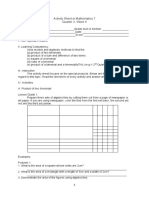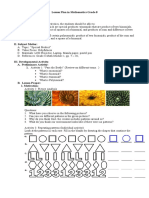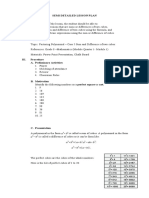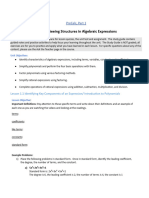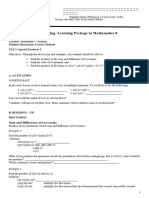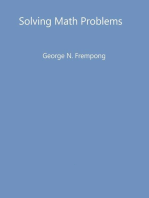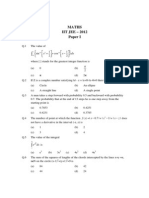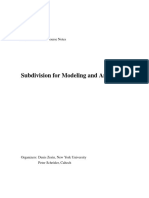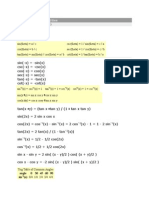M2L4 Special Products
M2L4 Special Products
Uploaded by
dorris09Copyright:
Available Formats
M2L4 Special Products
M2L4 Special Products
Uploaded by
dorris09Original Title
Copyright
Available Formats
Share this document
Did you find this document useful?
Is this content inappropriate?
Copyright:
Available Formats
M2L4 Special Products
M2L4 Special Products
Uploaded by
dorris09Copyright:
Available Formats
MATH 7
MODULE 2 – LESSON 4
Special Products
Pre-requisite Concepts: Addition and Multiplication of Polynomials
Objectives:
In this lesson, you are expected to:
Find (a) inductively, using models and (b) algebraically the
1. product of two binomials
2. product of a sum and difference of two terms
3. square of a binomial
4. cube of a binomial
5. product of a binomial and a trinomial
A. Product of two binomials
General formula for the product of two binomials (a + b)(c + d). This form is sometimes called the FOIL
method where the letters of FOIL stand for first, outside, inside and last.
Activity 1 Find the Product of the following:
B. Product of a sum and difference of two terms
The general form is (a + b) (a – b) = a2 – b2
Example: Find the product of (x – 5) (x + 5)
(You can follow the FOIL Method which will produce the same answer or you can simply follow the
general form.)
(x – 5)(x + 5) = x2 + 5x – 5x – 25 = x2 – 25
Activity 2. Find the product of the following
1. (2x + 3) (2x – 3)
2. (x + y2) (x – y2)
C. Square of a binomial
The square of a binomial is always a trinomial. It will be helpful to memorize these patterns for
writing squares of binomials as trinomials:
(a + b)2 = a2 + 2ab + b2
(a – b)2 = a2 -2ab + b2
Examples: Square each binomial.
a) (x + 4)2
(x + 4)2 = x2 + 2(x · 4) + 42
= x2 + 8x + 16
b) (2y – 3)2
(2y – 3)2 = (2y)2 – 2 (2y · 3) + 32
= (2y)2 – 2 (6y) + 32
= 4y2 – 12y + 9
c) (3p – 2q2)2
(3p – 2q2)2 = (3p)2 – 2(3p · 2q2) + (2q2)2
= 9p2 – 2(6pq2) + 4q4
= 9p2 – 129q2 + 4q4
D. Cube of a binomial
The cube of the binomial (x + 1) can be expressed as (x + 1) 3. This is equivalent to (x + 1)(x + 1)(x
+ 1).
Analysis: (Follow this outline to answer the next activity)
1. Show that (x + 1)2 = x2 + 2x + 1
By using special products for the square of a binomial, we can show that (x + 1)2 = x2
+ 2x + 1.
2. How are you going to use the above expression to find (x + 1) 3?
(x + 1)3 = (x + 1)2(x + 1) = (x2 + 2x + 1)(x + 1)
3. What is the expanded form of (x + 1)3?
(x + 1)3 = x3 + 3x2 + 3x + 1
Activity 3: Use the techniques outlined above to find the following:
1. (x + 2)2
2. (x – 1)2
3. (x – 2)2
Questions to Ponder:
1. How many terms are there in each of the cubes of binomials?
2. Compare your answers in numbers 1 and 2?
a. What are similar with the first term? How are they different?
b. What are similar with the second terms? How are they different?
c. What are similar with the third terms? How are they different?
d. What are similar with the fourth terms? How are they different?
3. Craft a rule for finding the cube of the binomial in the form (x + a) 3. Use this rule to find (x + 3)3.
Check by using the method outlined in the activity.
4. Craft a rule for finding the cube of a binomial in the form (x –a )3. Use this rule to find (x – 4)3.
5. Use the method outlined in the activity to find (2x + 5) 3. Can you apply the rule you made in
number 3 for getting the cube of this binomial? If not, modify your rule and use it to find (4x +
1)3.
Answers:
1. The cube of a binomial has four terms.
2. First, make sure that you write the expanded form in standard form.
a. The first terms are the same. They are both x3.
b. The second terms have the same degree, x2. Their coefficients are different. (3 and 6).
c. The third terms have the same degree, x. Their coefficients are 3 and 12.
d. The fourth terms are both constants. The coefficients are 1 and 8.
Make sure that the students notice that the ratio of the coefficients of the terms are 1, 2, 4 and
8. These correspond to the powers of the second term 20, 21, 22, and 23.
3.
4.
5.
END OF MODULE 2.
You might also like
- ATI TEAS Calculation Workbook: 300 Questions to Prepare for the TEAS (2024 Edition)From EverandATI TEAS Calculation Workbook: 300 Questions to Prepare for the TEAS (2024 Edition)No ratings yet
- (Mathematics and Its Applications 363) Abdul J. Jerri (Auth.) - Linear Difference Equations With Discrete Transform Methods-Springer US (1996)No ratings yet(Mathematics and Its Applications 363) Abdul J. Jerri (Auth.) - Linear Difference Equations With Discrete Transform Methods-Springer US (1996)455 pages
- Grade 7 Math Lesson 25: Special Products Learning GuideNo ratings yetGrade 7 Math Lesson 25: Special Products Learning Guide7 pages
- Activity Sheet in Mathematics 7 Quarter 2-Week 6: A. Product of Two Binomials100% (1)Activity Sheet in Mathematics 7 Quarter 2-Week 6: A. Product of Two Binomials8 pages
- I. Readings/Discussions:: Task 1: Product of Two BinomialsNo ratings yetI. Readings/Discussions:: Task 1: Product of Two Binomials6 pages
- FIRST-Q-WEEK-1-2022-23 Science or Mapeh Module 1 Week 1No ratings yetFIRST-Q-WEEK-1-2022-23 Science or Mapeh Module 1 Week 15 pages
- Mathematics: Quarter 2 - Module 6: Special ProductsNo ratings yetMathematics: Quarter 2 - Module 6: Special Products22 pages
- Revalidated - MATH - GR8 - QTR1-MODULE-2 - (28 Pages)No ratings yetRevalidated - MATH - GR8 - QTR1-MODULE-2 - (28 Pages)28 pages
- MODULE 2 - Factoring Polynomials (Part II)No ratings yetMODULE 2 - Factoring Polynomials (Part II)12 pages
- Unit 1: Module 1: SPECIAL PRODUCTS and FactorsNo ratings yetUnit 1: Module 1: SPECIAL PRODUCTS and Factors25 pages
- Math8 - q1 - Mod1b - Factoring Perfect Square and General Trinomials - 08092020No ratings yetMath8 - q1 - Mod1b - Factoring Perfect Square and General Trinomials - 0809202025 pages
- A Learning Resource Pack For Flexible Learning: SCHOOL YEAR 2020 - 2021No ratings yetA Learning Resource Pack For Flexible Learning: SCHOOL YEAR 2020 - 20219 pages
- MATH 8-Q1-WK 1 - FOR TEACHER Deped Negros Oriental100% (1)MATH 8-Q1-WK 1 - FOR TEACHER Deped Negros Oriental25 pages
- Take Note:: Miracle Light Christian Academy Casilagan, City of Ilagan, Isabela Mathematics 8No ratings yetTake Note:: Miracle Light Christian Academy Casilagan, City of Ilagan, Isabela Mathematics 84 pages
- Factoring Special Polynomial Forms (Difference of Squares and The Square of Binomial)No ratings yetFactoring Special Polynomial Forms (Difference of Squares and The Square of Binomial)4 pages
- Test Questionnaire (Pelpinosas, Hazel Faith N.)No ratings yetTest Questionnaire (Pelpinosas, Hazel Faith N.)3 pages
- Different Strategies in Factoring PolynomialsNo ratings yetDifferent Strategies in Factoring Polynomials4 pages
- Recall: Perfect Squares Are Numbers or Expressions That Can Be ExpressedNo ratings yetRecall: Perfect Squares Are Numbers or Expressions That Can Be Expressed5 pages
- Multiplying Binomials and Special ProductsNo ratings yetMultiplying Binomials and Special Products20 pages
- Mathlearnermodule 130708064103 Phpapp02 PDFNo ratings yetMathlearnermodule 130708064103 Phpapp02 PDF112 pages
- Factoring and Algebra - A Selection of Classic Mathematical Articles Containing Examples and Exercises on the Subject of Algebra (Mathematics Series)From EverandFactoring and Algebra - A Selection of Classic Mathematical Articles Containing Examples and Exercises on the Subject of Algebra (Mathematics Series)No ratings yet
- Trigonometric Ratios to Transformations (Trigonometry) Mathematics E-Book For Public ExamsFrom EverandTrigonometric Ratios to Transformations (Trigonometry) Mathematics E-Book For Public Exams5/5 (1)
- Math 7 Module 1 Lesson 3 Addition and Subtraction of Polynomials ObjectivesNo ratings yetMath 7 Module 1 Lesson 3 Addition and Subtraction of Polynomials Objectives6 pages
- Mathematics 7 Module 1 Lesson 2 Polynomials Pre-Requisite Concepts: Constants, Variables, Algebraic ExpressionsNo ratings yetMathematics 7 Module 1 Lesson 2 Polynomials Pre-Requisite Concepts: Constants, Variables, Algebraic Expressions3 pages
- Linear Algebra and Its Applications: Shawn Farnell, Rachel PriesNo ratings yetLinear Algebra and Its Applications: Shawn Farnell, Rachel Pries9 pages
- CNS-Problems-cryptography 5 Elliptic Curves in CryptographyNo ratings yetCNS-Problems-cryptography 5 Elliptic Curves in Cryptography21 pages
- Apex Learning Algebra 2 Semester 1 1.4.4 Practice - Modeling Solving InequalitiesNo ratings yetApex Learning Algebra 2 Semester 1 1.4.4 Practice - Modeling Solving Inequalities5 pages
- C. Von Kerczek and E.O. Tuck. The Representation of Ship Hulls by Conformal Mapping FunctionsNo ratings yetC. Von Kerczek and E.O. Tuck. The Representation of Ship Hulls by Conformal Mapping Functions15 pages
- Maths Solution MARCH 2024 Annual Exam 1 SolutionNo ratings yetMaths Solution MARCH 2024 Annual Exam 1 Solution16 pages
- Lecture Notes: Department of Computer EngineeringNo ratings yetLecture Notes: Department of Computer Engineering15 pages
- Exact Solutions of The Sextic Oscillator From The Bi-Confluent Heun EquationNo ratings yetExact Solutions of The Sextic Oscillator From The Bi-Confluent Heun Equation17 pages
- Grade IX Mid Year Examination Paper 2024-25No ratings yetGrade IX Mid Year Examination Paper 2024-253 pages
- PDF Theory of Distributions 2nd Edition Svetlin G. Georgiev download100% (4)PDF Theory of Distributions 2nd Edition Svetlin G. Georgiev download40 pages





